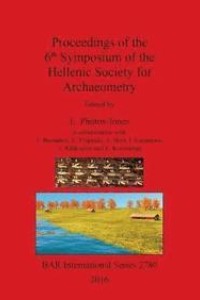
Liknande böcker
Comparative Archaeology and Paleoclimatology : Socio-cultural responses to a changing world
Bok av Maximilian O Baldia
Multidisciplinary Old and New World research, using high quality paleoenvironmental and archaeological data, looks for correlations between climatic oscillations and socio-cultural adjustments in nomadic hunter-gatherer, horticultural, sedentary agricultural, and early urbanized societies. The outright collapse of cultural systems, sometimes associated with radical climate change, is not readily demonstrated and some contributions attribute culture change primarily to human agency. Others indicate that different cultures in diverse regions and times employ varying adjustment strategies, including economic and technological innovations (i.e., agriculture, wheels, monumental architecture, metallurgy etc.) and exhibit religious and social upheaval, warfare, genocide, or migration in coping with a changing world. Contents: 1) Dangerous Regions: A Source of Cascading Cultural Changes (Joel D. Gunn, William J. Folan, and Joseph M. Herbert); 2) Risky Business: Caddo Farmers Living at the Edge of the Eastern Woodlands (Timothy K. Perttula); 3) Environmental Change, Population Movements, and the Archaeological Record (Dean R. Snow); 4) Climate, Culture, and Change: From Hunters to Herders in Northeastern and Southwestern Africa (Ralf Vogelsang and Birgit Keding); 5) Fits and Starts: Why Did Domesticated Animals Trickle Before They Splashed Into Sub-Saharan Africa? (David K. Wright); 6) Socio-Cultural Responses to a Changing Environment: The Shashe-Limpopo Valley Since ca. AD 900 (Munyaradzi Manyanga); 7) Mesolithic Settlements of the Ukrainian Steppes: Migration as Sociocultural Response to a Changing World (Olena V. Smyntyna); 8) The Early Megaliths of SW Atlantic Europe and the Inference of the Socio-economic Organization of their Builders (8th to 6th millenniums BC) (David Calado et al.); 9) Pre-neolithization: Reconstructing the Environmental Background to Life Way Changes in the Late Mesolithic of the Carpathian Basin (Pal Sumegi); 10) The Mesolithic-Neolithic Transition in the Carpathian Basin: Was there an Ecological Trap During the Neolithic? (Pal Sumegi et al); 11) New Data Concerning the Detection and Nature of Human Impact on the Mohos Lakes, Northeast Hungary (Imola Juhasz); 12) Late Neolithic Man and Environment in the Carpathian Basin: A Preliminary Geoarcheological Report from Cs szhalom at Polgar (Pal Sumegi et al); 13) Freshwater Mussels and Life in the Late Neolithic Tell of Hodmez vasarhely-Gorzsa, southeastern Hungary (Sandor Gulyas and Pal Sumegi); 14) Imprints of the Anthropogenic Influences in a Peat Bog from Transdanubia, Hungary (Imola E. Juhasz); 15) Breaking Unnatural Barriers: Comparative Archaeology, Climate, and Culture Change in Central and Northern Europe (6100-2700 BC) (Maximilian O. Baldia); 16) Cultural Geography in the Context of Climatic and Environmental Change in the Late Neolithic and Eneolithic of the Morava Valley (Matthew T. Boulanger); 17) Taphonomic processes affecting monumental earthen architecture as a proxy for climatic change (Douglas S. Frink); 18) Neolithic Settlement in the Central-European Mountains (Pawel Valde-Nowak); 19) Separating Natural and Anthropogenic Influences on Past Ecosystems: The Testate Amoebae and Quantitative Paleoenvironmental Reconstruction (Edward A.D. Mitchell); 20) Environmental and Cultural Change in the Alps: Seeking Continuity in the Bronze Age Lake-Dwelling Tradition (Francesco Menotti); 21) Chapter 22: Society and Ecology During the Middle Bronze Age of Southern Scandinavia (Lars Larsson)."







